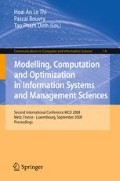Abstract
Closure systems arise in many areas as databases, datamining, formal concept analysis, logic and artificial intelligence. Several representations were studied to deal efficiently with closure systems and to be efficient tools in various areas. Implicational basis is a particular representation which have the advantage to be a short representation of datas. This paper states on operation of join of closure systems using their implicational basis representations. Computation of an implicational basis of join of closure systems given by their implicational basis is a problem that can’t be solve in polynomial time in size of the input in general. We present here a polynomial algorithm that solves this problem when the given implicational basis corresponding to the given closure systems are direct.
Access this chapter
Tax calculation will be finalised at checkout
Purchases are for personal use only
Preview
Unable to display preview. Download preview PDF.
References
Guigues, J.-L., Duquenne, V.: Famille minimale d’implications informatives résultant d’un tableau de donneés binaires, Matheḿatiques et sciences humaines, 24 (1986)
Eiter, T., Gottlob, G.: Hypergraph transversal computation and related problems in logic and AI. In: European Conference on Logics in Artificial Intelligence (JELIA 2002), pp. 549–564 (2002)
Ganter, B.: Finding closed sets under symmetry, FB4-Preprint 1307, TH Darmstadt (1990)
Ganter, B., Wille, R.: Formal Concept Analysis, Mathematical Foundations. Springer, Heidelberg (1999)
Mannila, H., Räihä, K.J.: On the complexity of inferring functional dependencies. Discrete Applied Mathematics 40(2), 237–243 (1992)
Eiter, T., Ibaraki, T., Makino, K.: Computing Intersections of Horn Theories for Reasoning with Models. Artificial Intelligence 110(1), 57–101 (1999)
Eiter, T., Ibaraki, T., Makino, K.: Disjunctions of Horn Theories and their Cores, Rutcor Research Report (1998)
Kautz, H., Selman, B.: Knowledge Compilation and Theory Approximation. Journal of the ACM 43(2), 193–224 (1996)
Birkhoff, G., Frink, O.: Representations of lattices of sets. Transactions of the American Mathematical Society 64, 299–316 (1948)
Author information
Authors and Affiliations
Editor information
Editors and Affiliations
Rights and permissions
Copyright information
© 2008 Springer-Verlag Berlin Heidelberg
About this paper
Cite this paper
Renaud, Y. (2008). Join on Closure Systems Using Direct Implicational Basis Representation. In: Le Thi, H.A., Bouvry, P., Pham Dinh, T. (eds) Modelling, Computation and Optimization in Information Systems and Management Sciences. MCO 2008. Communications in Computer and Information Science, vol 14. Springer, Berlin, Heidelberg. https://doi.org/10.1007/978-3-540-87477-5_48
Download citation
DOI: https://doi.org/10.1007/978-3-540-87477-5_48
Publisher Name: Springer, Berlin, Heidelberg
Print ISBN: 978-3-540-87476-8
Online ISBN: 978-3-540-87477-5
eBook Packages: Computer ScienceComputer Science (R0)

